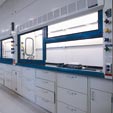| A Place of Discovery
Custom-Designed Building Catapults SPU’s Science
Program to a New Level
You probably don’t need a quiz to drive home the point
that science has everything to do with the nature and quality
of our daily lives. Try scanning newspaper headlines: “Power
Outage Darkens Northeast,” “NASA Launches Infrared Telescope
Observatory,” “Spawning Salmon Carry Industrial Pollutants.”
 |
 |
| After a two-year construction process,
SPU's state-of-the-art science facility stands ready to meet
the needs of 21st century student. |
Scientists and non-scientists alike face a dilemma:
How do we keep up with the new discoveries that are changing our
world so profoundly?
For students and faculty at Seattle Pacific
University, the ability to explore God’s world — and
thus make intelligent personal and public policy decisions in
science-related areas — has increased exponentially in recent
months. An award-winning science facility dedicated to outstanding
teaching and research opened its doors this autumn.
The building
represents years of imagination, planning and construction. It
also symbolizes a new commitment to the sciences at SPU.
“As
Christians, we must be scientifically literate if we have any hope
of making a difference in the world,” says SPU President Philip
Eaton. “This building demonstrates our vision for the
sciences at Seattle Pacific.”
That vision, says Dean of the College of Arts and Sciences
Bruce Congdon, is about shared discovery — and ultimately about
engaging the culture and changing the world. “We live in a
time of revolution,” he says. “To be effective sources
of light and hope in this technological world, we want to fully integrate
the language and practice of scientific discovery into the fabric
of a Seattle Pacific education.”
Congdon, a longtime professor of biology at SPU, served as faculty
champion for the new building. After years of teaching and researching
in the Miller Science Learning Center (MSLC), it was clear to him
that the building’s open lab concept was fundamentally flawed. “There
were not only organizational problems with multiple disciplines sharing
the same lab space,” he says, “there were safety problems
as well.”
When the science faculty brought a list of urgent needs to Eaton,
he agreed that SPU’s science program needed rethinking. “But
I said we would never make a major investment in anything without
vision,” recalls the president. “And so, with the faculty,
we proceeded to craft a vision.”
It was a turning point, says Vice President for Academic Affairs
Les Steele. “We started to think together as a community about
why it is important for a Christian university to have a strong science
pro-gram — and about what a new program and a new building
might look like.”
Out of the discussion emerged a plan for a science curriculum focused
on three things: training professional scientists, preparing science
teachers and assisting students of all disciplines to become scientifically
literate citizens. The plan included a centerpiece building
dedicated to the foundational concepts of undergraduate research
and public access to the sciences.
Today, the new Science Building features eight undergraduate research
laboratories and 11 teaching laboratories with shared instrumentation
suites. A “discovery room” on the first floor will feature
science displays; windows in the laboratories enable visitors to
see “science in action”; and a 70-seat lecture hall accommodates
public events as well as classes. Departing from the shared-space
model of the MSLC, the new facility allocates dedicated space to
specific areas of scientific study and their respective sub-disciplines.
However, cross-disciplinary study is encouraged, says Congdon, who
notes that the building’s design allows for biology, chemistry,
biochemistry and psychology to work in collaboration.
When SPU junior Candice Lengyel first stepped into the Science Building
this fall, she couldn’t believe her eyes. “I was just
bubbling — it almost took my breath away,” says the future
medical student. “Everything is custom-designed for what the
professors had in mind for us, and that is so exciting.”
Lee Buckingham agrees. The senior biology major and teaching
assistant says students are enjoying the Science Building so much
that they linger in the labs long after class is over. “Nobody
ever stuck around in the old labs, but students just really love
this building.”
Perhaps most impressive are the undergraduate research projects already
underway in the new building. One such project, led by SPU Assistant
Professor of Chemistry Gregory Phelan and students Kolby Allen and
Daniel Rowe, resulted in a paper recently submitted to a peer-reviewed
journal of the Society of Photo-Optical Instrumentation Engineers.
The paper asserts that different combinations of light-emitting material
may result in brighter and more efficient light-emitting devices.
How is that significant? Imagine being able to watch a color TV as
thin as a sheet of paper and less expensive than the Plasma versions
currently on the market.
Seattle Pacific’s recommitment to
the sciences has resulted in the largest enrollment in science disciplines
in the University’s history — an increase of 35 percent
over last year. To top it off, the opportunities for SPU science
majors after graduation have never been better. Last year’s
premed graduates boasted a 92 percent acceptance rate into medical
school.
“Our science faculty is taking our program to the next level,” says
Eaton. “We now have exceptional facilities and a great team
of scientists leading the way into new territory.”
Says Congdon: “We’re putting students on a catapult and
trying to give them enough velocity that they can keep up with the
rapid increase in scientific knowledge and application. The
field is moving fast, so we need to give them momentum.”
— BY SARAH JIO AND CLINT KELLY
— PHOTOS BY MIKE SIEGEL
Back to the top
Back to Home |
|

|
 |











